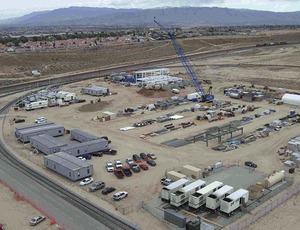
It’s been almost a decade since the groundbreaking at the Foxborough Industrial Park in Victorville, Calif., 85 miles northeast of Los Angeles, where the city’s leaders once made plans based on the fact that Victorville was, at the time, the second-fastest-growing city in the U.S.
Little remains of the grand plans or the small, partly completed powerplant project that was going to be the source for electrical power for two companies that were deciding, in 2004, whether to move operations to Victorville.
Instead, the powerplant project wasted tens of millions of dollars and became a symbol of failed hopes, dismay and recrimination. The city struggled with a bad budget deficit and then the recession hit, but things are better now.
Last February, insurers for the Carter & Burgess unit of Jacobs Engineering Group, the city’s adviser and designer for the work, settled the city’s lawsuit against the firm for $52,116,367, the full amount of the project costs incurred by the city (some sources put the all-in cost of the project much higher.) The city is using the money to patch some of the huge financial holes left by the project.
A San Bernardino County grand-jury report, issued last July, noted that neither Victorville nor Carter & Burgess/Jacobs had done enough risk assessment or used proper controls on the project.
The settlement's final impact may be felt more broadly in California and elsewhere in the U.S. In winning the settlement, Victorville’s attorneys successfully argued that an engineer’s responsibility to its client can be, at times, much more than the customary standard of care. And Jacobs Engineering may have learned something about the potential liability involved when serving as both adviser and designer to a small, inexperienced but ambitious client.
Soon after the jury verdict in 2010, Karen Erger, director of practice risk management for insurance broker Lockton, wrote that, every once in a while, a case comes along suggesting that engineers owe their clients not the usual standard of care but a fiduciary one, “the very highest.” She called her report on the subject “The Fiduciary Bomb” and advised engineering firms to take defensive measures by avoiding entangling contact terms.
Two years before the settlement, a jury had awarded Victorville the huge damages following seven tumultuous weeks of trial, in 2010, in California Superior Court in nearby Riverside, Calif. There were 203 exhibits admitted, and 28 witnesses testified. While Jacobs appealed the jury verdict, its legal team finally decided not to wait for an appeals-court decision. Each passing day added another $14,000 of interest to the judgment.
Glenn E. Turner III, one of the key attorneys for Victorville, praised the Carter & Burgess/Jacobs attorney for convincing the company and its insurers to settle before the appeals-court ruling was issued. “A difficult job,” says Turner.
According to Victorville’s current city manager, Doug Robertson, the city used $30 million of the settlement to pay project-related debt and another $22 million to pay off debt from the city’s water district. Another $2 million was used to purchase a water boiler for Nutro, a pet-food supplier and one of the companies that, along with ConAgra, started local operations in Victorville around 2005.
Both Carter & Burgess/Jacobs and its outside attorney failed to return ENR calls for comment on the case or the settlement.
Could the company have seen the risk that was evolving? The San Bernardino County grand jury noted that Victorville had been lax in its controls and risk assessment in building—with a development partner—another, bigger generating-plant project that went into service in 2003. But that earlier project wasn't known at the time.
The Early Conflict Over Payment
The story starts in 2002, when the city wanted to attract investment by establishing cheap energy sources at its own electricity-generating plants. Victorville hired Carter & Burgess to determine the feasibility and design a modest, 17.5-MW powerplant for the two new businesses coming to town. The process started with Carter & Burgess producing a series of economic pro formas, or revenue projections. After delays and cost overruns, each side blamed the other, and Victorville cancelled the project in 2006. The city was stuck for the costs—or so it seemed.
Carter & Burgess then sued the city for a disputed final payment, seeking $106,000, but Victorville struck back with a countersuit for essentially all the costs of the unfinished job.
In the lawsuit, Victorville argued that Carter & Burgess breached its contract and failed to live up to the accepted professional level of care by producing poor-quality designs and failing to supervise the project development. (No legal action was brought against the project’s main contractor, TIC, Englewood, Colo.)
Carter & Burgess’ main attorney, Paul A. Lax, did seek to dismiss the fiduciary duty claim in a motion requesting summary judgment. Then, just before the trial, Carter & Burgess/Jacobs offered $2 million as a settlement.
That failed. But when Carter & Burgess/Jacobs didn’t make a more substantial offer at a settlement conference with the judge, Victorville’s claims were destined to be tried by a jury in a state court. While juries can provide plaintiffs a major tactical advantage, complex business cases in the U.S. are often decided by a judge who is more familiar with such cases and less likely to be swayed by emotion.
During the trial that started in October 2010, the legal strategies became clearer.
Long, Slow Procurement Described
In his opening statements, Lax emphasized to the jury the long, slow process of choosing to build the powerplant and the numerous choices made by decision-makers in Victorville, including the mayor, to build an islanded cogeneration plant, which was the costliest option.
Early in the process, in 2003, Carter & Burgess originally estimated the cost of the powerplant project at $22 million.





Post a comment to this article
Report Abusive Comment